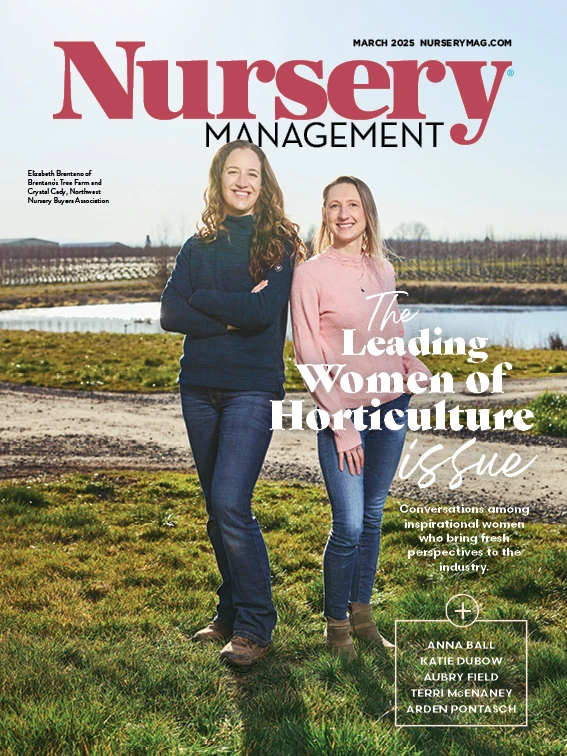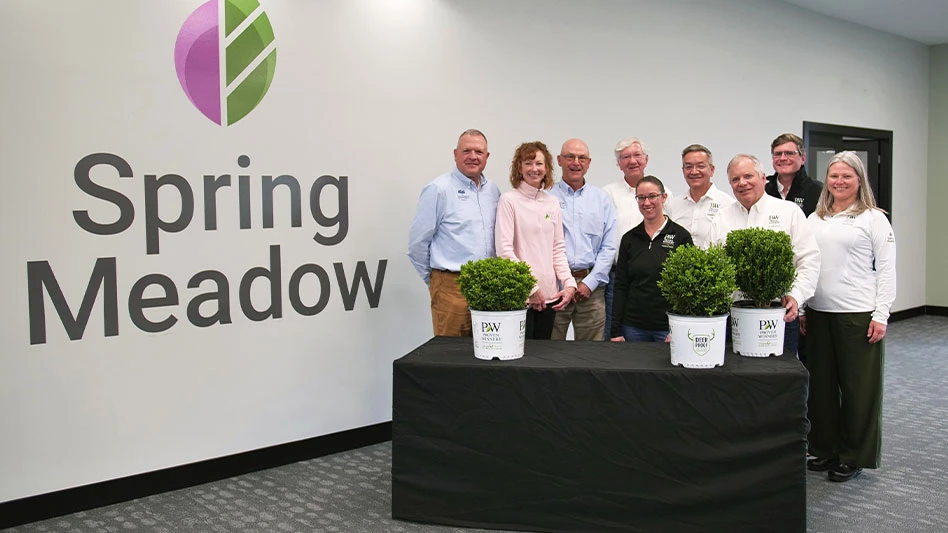
Editor's Note: This article originally appeared in the March 2025 print edition issue of Nursery Management under the headline "Gratitude as a marketing strategy."
This “Marketing Confidential” column begins with a story. And let me preface it to say that I started my research for it shortly after Thanksgiving. For background, I took an informal poll of about a dozen marketing professionals I respect.
Hang with me while I explain.
If you think back to around the holidays, did you notice anything about the communications you were receiving? On an almost daily basis, my email, text messages, social media feeds, even my snail mailbox were like Dursley’s fireplace tossing out personalized letters and year-end appeals. Typically, they offered heartfelt thanks along with asks for this or that.
Several communications featured holiday messaging wrapped in requests to support charitable causes or non-profit organizations. One was from my journalism school alma mater. Another was from a sponsorship organization, a pet rescue and on and on it went.
All of them got me thinking about our horticulture industry and how we market our products and services. I couldn’t put my finger on it at the time, but there seemed to be a slimmer of similarity among all the materials. And for days it fought for clarity in my brain.
I remember the light bulb moment like it was yesterday.
Light bulb moment
It was an unusually warm day in early December (I’m in the Chicago area), but my office was chilly. My little electric fireplace was going, my crochet afghan lounged on my lap and I was sipping blissfully hot coffee from my big white mug.
Feeling grateful for the small things that keep me comfy, I stared curiously at my email. I glanced over at my text messages, then tilted my head at the stack of mail splayed on the side of my desk. Huh. I leaned back in my chair a bit startled.
Allow a brief interjection here, please.
I’ve been doing this a while — this thing called “horticulture and agriculture communications” has consumed the better part of my adult life. But what I discovered was something I’d never realized before.
Now as general business practice, this thing I’m going to explain in a minute is always on my mind. It’s part-and-parcel of professional counsel I’ve given over many years. But suddenly it had a real, meaningful, applicable label. I did a face palm. “Oh, wow,” I realized.
Gratitude is a marketing strategy.
A strategy. In addition to an emotion, a messaging tool and a general business practice whose cousin is kindness, gratitude is a marketing strategy. There’s a difference here — a nuance to this multifaceted gem that is precious in both business and in life. But what does it have to do with growing and selling plants?
Everything!
Gratitude informs experience
Gratitude has everything to do with a company’s vision, mission and creativity. It is inherent in a company’s values and reason for being in the marketplace. It informs perspectives and programs that lead to outcomes and results, like achieving goals and generating sales.
It is the spark of human ingenuity that births success. Gratitude drives human beings to do better, be better and to accomplish “big and little scary things” when the anxiety of doing anything at all might otherwise send us dashing back to bed.
With gratitude as a marketing strategy, benefits are reciprocal. It sends ripples of goodwill into the marketplace that benefits everyone. It grows respect and reputations and reinforces the desire to do business with a company that lives its values of authentically honoring people.
Gratitude elicits specific actionable outcomes. For example, I support my alma mater because I feel grateful for the education I received and want to pay it forward. I give because I receive. The benefits of my experience inform my decision to share my gratitude with someone else — someone I may not even know. And then, that someone passes it forward because they, too, feel gratitude for the education they received by our alma mater. And so, on it goes.
Sincere gratitude is best friends with loyalty.
The relationship becomes beneficial, rather than transactional. Through its products, plant nurseries — indeed, every link of the plant business chain — provide health, wellness, environmental and community-enrichment benefits that are unlike any benefits in any other industry. Our horticulture industry — and especially those who grow its plants — are inherently centered in gratitude as a business marketing strategy.
Creating brand ambassadors
Before my “ah-ha moment,” in all that I had read, discussed and studied about my craft and my profession through the years, I have honestly never seen or heard the practice of gratitude labeled as a strategy. On that early December day, this label-concept jazzed me so much that I shouted it to a colleague in another room.“Hey! Gratitude is a marketing strategy!”
I ran it up the flagpole of my adult children, all experienced marketers. I put it in my email signature. I made a conscious effort over the next few weeks to practice gratitude as a marketing strategy. And I’ll be darned, it works.
I had a relentless desire to talk about gratitude as a marketing strategy with people who do what I do, to double-check that I am, in fact, A.) onto something here and B.) I’m not simply being clueless by not being in the know of what others who do what I do professionally have known for years.
Gratefully, I’m onto something. One of the pros I talked with even exclaimed, “Sue! You really need to write a column about this!”
So. Here we are.
“Without gratitude in marketing, activity is just transactional,” a colleague said. “It’s an exchange of goods or services for an agreed-upon amount of money or other form of payment. Of course, this may be all that is needed in order to balance the books. But it is a long way from engaging a community and creating brand ambassadors that will be there for the long haul, in good times and bad.”
Gratitude as a marketing strategy sends ripples of goodwill into the marketplace that benefits everyone.
Five steps ahead
If you’ve read “Marketing Confidential” for a while now (thank you, I am grateful!), you’ll recall that I encourage my “Five-Steps-Ahead Approach” to brand communications in business marketing and especially in the business of marketing plants. You’ll also recall my belief that people don’t want to do business with logos. While brands are vital and beloved, I believe they also don’t want to do business with brands per se.
People want to do business with people.
This applies whether communications are business-to-consumer or business-to-business. Thinking five steps ahead with regards to planning gratitude as a strategy means thinking through “what if?” scenarios. For example, if this happens, then what, etc. It incorporates empathy and consideration for others, identifies objectives, sets goals, develops messaging and executes outreach.
“Customers don’t want to be seen as a number,” a colleague said. “They want to be appreciated as people who have chosen to patronize your business. A little bit of forethought can go a long way.”
In other words, customers will feel a certain way about the experience they have with the company, including its products and services, because of its people. That’s when logos and brands matter — when ‘people come first’ is the planned strategy through gratitude marketing that is inherent in the company’s DNA. And their experience will determine their next steps with you as their customer.
“When gratitude is missing it can create a string of one-time customers,” a nursery colleague said. “Returning customers may dwindle because you’re not meeting their expectations in outreach or service.”
It seems obvious, doesn’t it? But it’s also one of those things that is so nuanced if you blink quick you might miss it.
Gratitude as a strategy informs experiential marketing.
“Gratitude should run a lot deeper than discounted pricing. To be sincere, it needs to be enriched in a company’s culture.”
Gratitude informs experience
“Gratitude towards our customers is built into our core values and culture,” another nursery colleague told me. They call their way of working, ‘customer centric.’
“We train front-line team members, and all the way up to top-level management, to do what we do with the customer in mind. In reality, our customers sign our paychecks,” this colleague said. “They have a choice whether to shop with us or not. Everything we do, every interaction with our nursery, is a chance to show our appreciation to our customers for literally putting food on everyone’s table.”
I hope by now you know that I’m not talking about DIY gratitude platitudes on social media. Rather, gratitude as a business marketing strategy centers on three concepts.
Gratitude is a super power. It informs successes and gives strength to struggles.
Gratitude is grounding. It focuses on the present as it informs values, planning and goal setting.
Gratitude is a connector. It networks with clients and customers through good times and challenging ones.
But what happens if ‘gratitude as a strategy’ isn’t genuine or is overdone? In my humble opinion — and in the consensus of the marketing pros I spoke with — customers can see right through that trick. Gratitude in that case, sadly, is nothing more than a gimmick or a gratitude platitude. It stands a very real chance of doing more harm to the brand than good. Strategy is lost, perhaps never even identified.
“Gratitude,” a colleague said, “should run a lot deeper than discounted pricing. To be sincere, it needs to be enriched in a company’s culture.”
Indeed. And it’s a simple concept, really: Gratitude is a marketing strategy.
But sometimes in business we tend to want to make things hard, don’t we? When the answers to our brand successes are right there. Right there in front of us.
On that chilly office day, Gratitude wanted me to notice that it had much more to offer than discounted pricing and free gifts with purchase. It got my attention. It snagged my intention. It got me to see that it is indeed a strategy. And the key to every successful business brand.
This article appeared in the March 2025 issue of Nursery Management magazine under the headline "Gratitude platitudes?"

Explore the March 2025 Issue
Check out more from this issue and find your next story to read.
Latest from Nursery Management
- The HC Companies, Classic Home & Garden merge as Growscape
- Terra Nova releases new echinacea variety, 'Fringe Festival'
- Eason Horticultural Resources will now officially be known as EHR
- BioWorks receives EPA approval for new biological insecticide for thrips, aphids, whiteflies
- Ellen Mackenbach-Lakeman appointed new CEO of Dümmen Orange
- The Growth Industry Episode 3: Across the Pond with Neville Stein
- Southern Garden Tour sets 2025 dates for trial garden open houses
- New book explores plants that thrive in Rocky Mountains




